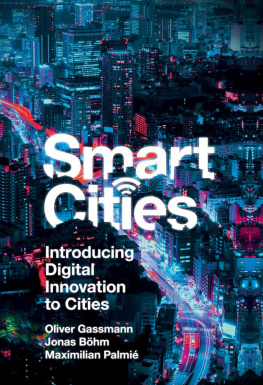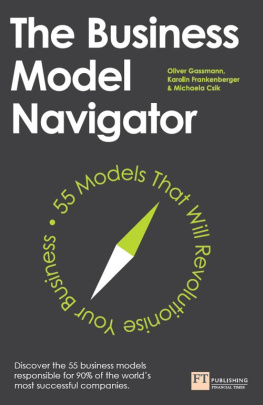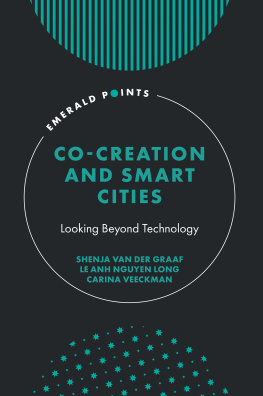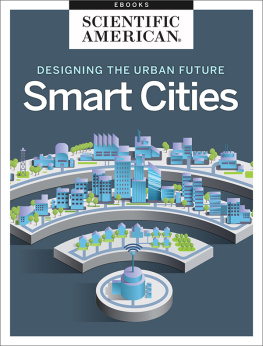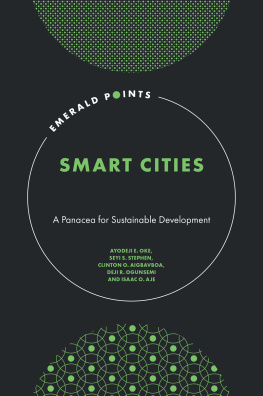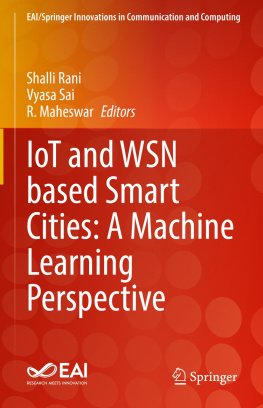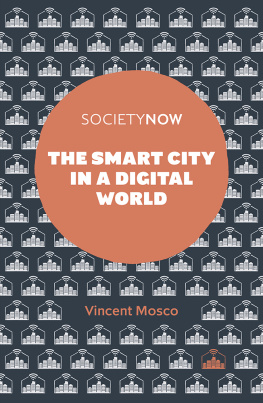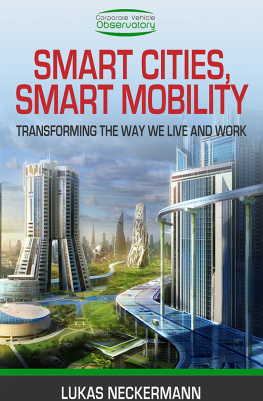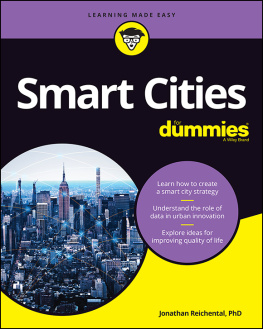Oliver Gassmann - Smart cities : introducing digital innovation to cities
Here you can read online Oliver Gassmann - Smart cities : introducing digital innovation to cities full text of the book (entire story) in english for free. Download pdf and epub, get meaning, cover and reviews about this ebook. year: 2019, genre: Children. Description of the work, (preface) as well as reviews are available. Best literature library LitArk.com created for fans of good reading and offers a wide selection of genres:
Romance novel
Science fiction
Adventure
Detective
Science
History
Home and family
Prose
Art
Politics
Computer
Non-fiction
Religion
Business
Children
Humor
Choose a favorite category and find really read worthwhile books. Enjoy immersion in the world of imagination, feel the emotions of the characters or learn something new for yourself, make an fascinating discovery.
- Book:Smart cities : introducing digital innovation to cities
- Author:
- Genre:
- Year:2019
- Rating:4 / 5
- Favourites:Add to favourites
- Your mark:
- 80
- 1
- 2
- 3
- 4
- 5
Smart cities : introducing digital innovation to cities: summary, description and annotation
We offer to read an annotation, description, summary or preface (depends on what the author of the book "Smart cities : introducing digital innovation to cities" wrote himself). If you haven't found the necessary information about the book — write in the comments, we will try to find it.
Smart cities : introducing digital innovation to cities — read online for free the complete book (whole text) full work
Below is the text of the book, divided by pages. System saving the place of the last page read, allows you to conveniently read the book "Smart cities : introducing digital innovation to cities" online for free, without having to search again every time where you left off. Put a bookmark, and you can go to the page where you finished reading at any time.
Font size:
Interval:
Bookmark:
SMART CITIES
Further praise for Smart Cities:
Smart cities require suitable technologies, sustainable business models, and proper administration processes. This book conveys concrete ways of how cities can become smart cities.
Oliver Deuschle, SMIGHT at EnBW, Germany
This book succinctly expresses why only one smart city can persist in face of location competition.
Yvonne Beutler, Vice President of City Council, Switzerland
Digitalization opens up myriad development possibilities in cities. This book expertly delineates various best practices as well as core elements of a systematic and strategic approach.
Prof. Thomas Schildhauer, Humboldt Institute for Internet and Society, Germany
Municipal utilities not only construct and operate essential digital infrastructure, but also new services for a smart city from waste disposal on demand to electromobility. This book can especially assist small public utility companies in their efforts to develop and realize a strategy for their smart city.
Katherina Reiche, Verband kommunaler Unternehmen e.V., Germany
The realization of smart city projects presupposes a uniform understanding of their relevant dimensions. This book and its smart city management model offer the ideal foundation for this crucial unification.
Orlando Gehrig, Swisspower Innovation, Switzerland
SMART CITIES
Introducing Digital Innovation to Cities
BY
OLIVER GASSMANN
JONAS BHM
MAXIMILIAN PALMI
University of St. Gallen, Switzerland

Emerald Publishing Limited
Howard House, Wagon Lane, Bingley BD16 1WA, UK
First edition 2019
Copyright 2019 Emerald Publishing Limited
Reprints and permissions service
Contact:
No part of this book may be reproduced, stored in a retrieval system, transmitted in any form or by any means electronic, mechanical, photocopying, recording or otherwise without either the prior written permission of the publisher or a licence permitting restricted copying issued in the UK by The Copyright Licensing Agency and in the USA by The Copyright Clearance Center. Any opinions expressed in the chapters are those of the authors. Whilst Emerald makes every effort to ensure the quality and accuracy of its content, Emerald makes no representation implied or otherwise, as to the chapters suitability and application and disclaims any warranties, express or implied, to their use.
British Library Cataloguing in Publication Data
A catalogue record for this book is available from the British Library
ISBN: 978-1-78769-614-3 (Print)
ISBN: 978-1-78769-613-6 (Online)
ISBN: 978-1-78769-615-0 (Epub)

Chapter 1 |
Chapter 2 |
Chapter 3 |
Chapter 4 |
. |
Chapter 6 |
Chapter 1 |
. |
Chapter 2 |
Chapter 3 |
Chapter 4 |
Chapter 6 |
The concept of the smart city promises to solve many of the urgent issues that accompany progressive urbanization overwhelming traffic congestion, strains on energy and water systems, delinquency, inadequate housing, and the lack of social inclusion through digitalization. Smart cities are therefore highly relevant for political decision makers in municipalities, administrative agencies, and nonprofit and civic organizations. Moreover, smart or ecosystem cities offer great potential for countless corporations in the fields of information technology, real estate, telecommunications, energy supply, auto-mobility, sensor systems, and data analytics. Accordingly, it is not surprising that numerous highly innovative companies, including IBM, Cisco, Telekom, Siemens, Toshiba, and Google, along with public utilities around the world, are actively investing in smart city development. Additionally, many startups are concurrently entering the Internet of Things (IoT) and energy fields, placing competitive pressure on established firms.
The social and political demands of the energy revolution, combined with the auspicious possibilities of an interconnected yet decentralized world within the framework of IoT, are accelerating the transformation of urban centers toward becoming smart cities. Despite the exploitation of existing potentials by lighthouse (i.e., pilot) cities, such as Barcelona, Munich, Lyon, and Vienna, most municipalities have pursued smart city opportunities only to a limited extent thus far. As a result, the discrepancies between leading smart cities and less ambitious cities are widening. The need for action is frequently discerned, yet the most appropriate path of action often remains unclear.
Various important questions about smart city development are still unanswered. What are the core elements of smart cities? What steps should be followed in building them? Where does the greatest potential lie? What is the ideal starting point? What procedures have other cities applied? What can be learned from pioneers in the field? Are the successes of the greenfield approaches applied by Asian smart cities transferable to other parts of the world? What methods and tools can be usefully implemented? What business models have participating firms used? How can diverse stakeholders be effectively integrated?
This book answers these questions in the form of solution paths, accompanied by design concepts and success factors. It covers the following main topics:
- the future of cities;
- an overview of smart cities;
- smart city management model;
- smart city lighthouses;
- guidelines for smart city transformation; and
- tools for making your city a smart city.
Cities today face tremendous challenges concerning livability, mobility, energy, and communication. These challenges are forcing them to reconsider their former self-conception, their functionality, and their service offerings. However, cities that focus actively on their objectives and on the requisite digital transformation can imagine and realize entirely new living spaces. To help them achieve this goal, they should learn from the experiences of pioneers in the field, which we call lighthouse cities. Urban centers can orient their strategies around the solutions and experiences of these role model cities, so as to design and execute their own situation-specific, customized transformation. These smart city management models serve as reference frames that provide basic fundamentals, offer recommendations for action, and contribute to the synchronization of the transformation process. The models are especially valuable as orientation tools introducing all stakeholders in a city or region to the smart city concept.
This book is based on ongoing research undertaken by the Institute of Technology Management (ITEM) and the Center for Energy Innovation, Governance, and Investment at the University of St. Gallen. Worthy of particular mention are the European Union project Smarter Together, the national energy research program comprising eight Swiss Competence Centers for Energy Research (SCCERs), and numerous projects of the ITEM with partners from the spheres of politics, administration, and the economy.
Font size:
Interval:
Bookmark:
Similar books «Smart cities : introducing digital innovation to cities»
Look at similar books to Smart cities : introducing digital innovation to cities. We have selected literature similar in name and meaning in the hope of providing readers with more options to find new, interesting, not yet read works.
Discussion, reviews of the book Smart cities : introducing digital innovation to cities and just readers' own opinions. Leave your comments, write what you think about the work, its meaning or the main characters. Specify what exactly you liked and what you didn't like, and why you think so.

